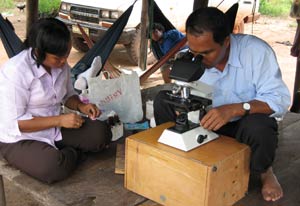Study shows parasite mutation behind drug-resistant malaria in Cambodia
January / February 2014 | Volume 13, Issue 1

Photo courtesy of Dr. Rick Fairhurst/NIAID
Scientists identified a mutation that enables malaria
parasites to survive the first-line drug targeting them,
raising hopes for possible new treatments.
A newly uncovered mutation in the malaria parasite
Plasmodium falciparum enables it to survive the most potent antimalarial drug available, artemisinin. This discovery, by an international collaboration that includes NIH's National Institute of Allergy and Infectious Diseases (NIAID), identifies not only a target for next-generation treatments but also a tool to monitor and help limit the global spread of resistant parasites.
The findings show "important determinants of artemisinin resistance," the researchers noted in their paper, published recently in
Nature . Finding genomic changes that cause drug resistance represents "a major advance in the fight against malaria and a significant step toward the eventual eradication of this disease," according to a press statement by Institut Pasteur, one of the funders. The hunt for genes underlying antimalarial drug resistance has frustrated global health researchers for decades, with the parasite always one step ahead. Over the years, resistance has emerged against nearly all antimalarial drugs, including most recently the latest arrow in the quiver, artemisinin. This loss of effective treatment is threatening malaria control and elimination activities worldwide.
Most cases of artemisinin resistance have appeared in western Cambodia, but clinics have reported instances in Burma, Thailand and Vietnam, according to WHO data. A major concern is that drug-resistant parasites will travel to sub-Saharan Africa, where malaria is most prevalent and deadly.
To search for genetic mutations in
P. falciparum that enable it to dodge the toxic effects of artemisinin, the international team developed a series of new detection methods involving biological, genomic, clinical and epidemiological approaches. First they induced artemisinin resistance in a parasite strain by exposing it to increasing artemisinin concentrations for 120 reproductive cycles over 5 years. They then sequenced the entire genome of this strain and a similar but nonresistant control strain, and compared the various mutations. Eight had developed in the laboratory, one of which occurred in the so-called "K13-propeller" allele.
The team confirmed this type of mutation occurred in artemisinin-resistant parasites sampled in Cambodia, and then mapped their presence in those patients who had suffered artemisinin-resistant infections. Their analysis confirmed the mutation's culpability in parasite resistance to artemisinin.
With this result, physicians and scientists now have a molecular marker that quickly detects artemisinin-resistant parasites, so they can efficiently track and contain their spread, as well as tailor patient treatments in real time to save lives and, ultimately, test new antimalarial drugs against these mutant parasites. The researchers are now investigating how the K13-propeller mutations evolve and if similar shields are developing in malarial parasites elsewhere in the world.
More Information
To view Adobe PDF files,
download current, free accessible plug-ins from Adobe's website .